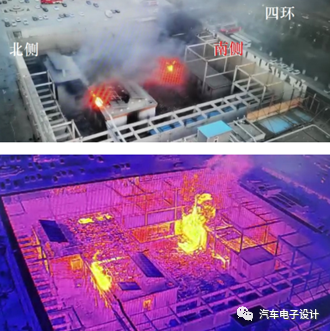Introduction
Yesterday, the Institute of Energy Storage and New Electric Technologies of China Electric Power Research Institute released a report on the accident analysis of the Beijing Jimei Dahongmen 25MWh DC power storage and charging integrated station project, which has been widely circulated. In this article, we will review the core content of the project accident analysis.
The Distance between the South and North Areas, and Potential Issues with Fire Water
According to the on-site accident report, there was no separation between the north and south areas after the south side had the problem, so the distance between the two sides was very limited. When discussing the water issue, there is indeed a reasonable inference here. The report states, “From the accident pictures, when firefighters used fire water to put out the fire in the energy storage system of the southern area, an explosion suddenly occurred in the northern area. Because the south and north areas are close together, the fire water may have come into contact with the energy storage system of the northern area when spraying the southern area. As the energy storage system is a high-voltage live body, spraying water may cause a short circuit in the live body and its circuits, which may cause a fire or expand electrical accidents. Therefore, before the fire in the energy storage system broke out, with a large number of energy storage batteries still unaffected, it is necessary to consider using water as a fire extinguishing medium with caution.“

Isolation
The report highlights the issue of management, which is very important. The project has two substations, one main and one secondary. The grid side should pass from the cable after the busbar on the low-voltage side is short-circuited at 380V. However, at this time, the fire brigade had already arrived. Since the energy storage batteries were not isolated, when firefighters entered (around 13:30, which was the discharge time for energy storage), explosion occurred “without any signs.”

There was no firewall design seen in the on-site fire protection design, and there was a lack of isolation and energy absorption facilities, which did not provide effective protection in the event of an explosion in the energy storage batteries. For other issues, please refer to the report. Since it is a post-accident analysis, many facts have not been reviewed one by one according to the design documents. Therefore, I personally believe that a set of standards should be formed for subsequent energy storage safety design, as required by the National Development and Reform Commission, to achieve 30 GWh by 2025, otherwise the problems brought about by the operation of so many centralized power stations will be very concentrated.
The above is my personal opinion:1. The use of parallel connections in energy storage makes the potential risk of short circuit caused by a single pinprick quite significant. Therefore, the electrical insulation design should be a key assessment item. Currently, the insulation testing in electric vehicles is very strict as they are all configured as 1P96-108S. It is relatively easy to connect large module cascades as in the example of Chinese battery maker Lishen who uses cylindrical small battery cells cascaded in small modules, but this also increases the potential risks.
- Due to the space available for energy storage, after the Samsung and LG energy storage accidents, existing thermal runaway or battery cell issue detection devices can be added to individual energy storage cabinets. Sensors for detecting smoke, pressure, and other parameters can also be installed. Fireproof isolation walls can be built between individual cabinets, and isolation walls are also needed between energy storage facilities.
Conclusion:
The application prospects for energy storage are currently in a rapid growth stage, especially when deployed in cities to offset the demand for high-speed charging power. Similar to the use of lithium iron phosphate in electric vehicles, taking a systemic approach is essential in order to support the rapid development of high-speed charging networks, rather than just focusing on individual components.
This article is a translation by ChatGPT of a Chinese report from 42HOW. If you have any questions about it, please email bd@42how.com.